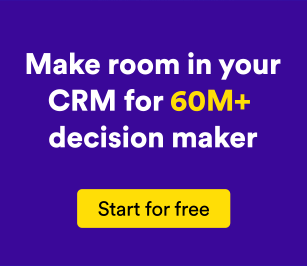Selling to a business means selling to multiple people (an average of 6-10), and you have to prove to all of them that your solution is going to be a worthwhile expense.
To make complex sales smoother, you need to have a clear picture of who has what kind of influence and how to tailor your communication to each person – AKA, a stakeholder map.
What is a stakeholder map?
A stakeholder map, or decision-maker map, is a visual way to outline the roles, responsibilities, and influence of the folks who are involved in deciding whether to buy your product. Put simply: it helps you identify and reach the people who contribute to the buying decision.
This isn’t busywork. Here’s how it can benefit your sale:
- Outlines how you can get every type of buyer on board
- Helps organize and prioritize your sales activities
- Aligns decision-makers and address any gaps
- Informs how you can build trust with each decision-maker
- Makes information easier to share
The best stakeholder maps are dynamic
It’s tempting to just copy-paste names and titles into an org chart and call it done. But if you really want your map to help you close deals, you need more info than a simple chain of command.
What you want to do is capture the flow of decisions at the enterprise you’re selling to. What affects the decision-making? What are the internal communications happening in between your meetings that you’ll want to influence?
You’re going to want your decision-maker map to show this movement of information and influence, not just who manages who.
Don’t worry if you’re not even sure where to start with this. We’ll break it down into super-simple steps for you.
How to create a decision-maker map that helps close deals
All right, so how exactly do you figure all this out? Don’t worry, we’ve got a simple process for you.
Find the decision makers
First things first: who are you talking to? You might have one contact you’ve started a conversation with, but you need to know the extent of who all is involved to move things further. There are a few ways you can find more people involved in the sale at your target company:
Ask questions
One of the simplest ways to find enterprise decision-makers is simply to ask your contact questions like:
- What person or team will use this product?
- What’s the typical purchasing process at X Company for this type of offering?
- Who else do I need to involve?
- Are there other departments that might benefit?
- What is your role in this purchasing decision?
- Who should see a demo?
Use intent data
Intent is a handy way to uncover potential for other stakeholders in a purchasing decision. Even the ones your contact doesn’t know about.
With intent data like Lusha’s, you can see the level of interest that a company has in a particular topic based on their online behaviors. This is measured geographically.
So that means if you’re talking to someone in Boston about staffing solutions, but you see that the Los Angeles branch of the company is showing a high intent score for staffing solutions, there’s probably a decision maker (or multiple decision-makers) there who need to be looped in on the conversation, too.
Dive into the company with Lusha
Using a sales intelligence platform like Lusha, you can find contacts you might be missing. Contact-level filters like job titles and seniority levels can help you pinpoint all the potential decision-makers you might need to talk to.
And we’re not just talking about getting their name and job title – you can get direct contact information for them too. If you use Lusha, that means no HQ numbers and no empty profiles, so you know you can connect with them directly.
Keep an eye out for key departments and roles
As you explore the company structure on Lusha, keep your eyes peeled for departments that could indicate how the buying process might work at your target company.
- If there’s a procurement manager or a lot of people in procurement roles, you can expect they will likely be the final (or close to final) stage.
- A large legal department means you can assume legal approval of your offering will be part of the purchase process.
- Lots of security titles could indicate that security is a big priority – meaning they’ll likely be involved.
Build out profiles for your contacts
Now you’ve got a list of people in the company that you’ll probably be talking to, it’s time to build out a profile to help sell to each one of them.
Assign roles
Start by assigning your contacts to common roles in the buying process. Some of those common roles include:
- Champions: The people who will recommend your solution and can help you get an “in” with everyone else. They provide input and feedback and have influence over the decision, but they’re not the final authority.
- End users: The people who actually use the product/service. Getting their buy-in is important if you want the sale to go well.
- Institutional stakeholders: Contacts in departments like IT, procurement, and legal whose approval is essential.
- Primary decision-makers. These are the people who have control of the budget that pays the bill.
Note other important details
In addition to their role, it can be helpful to build out a few more details in the profile of each decision-maker:
- Priorities: What’s the most important thing they need to know about your solution? What problems are they looking to solve for their organization?
- Metrics: How are they evaluated on a successful purchase? What company-wide metric is their role responsible for?
These details will help you figure out what kind of information they need from you as well as white might incentivize them.
Tailor your communication
This is the part where your decision-maker map comes in handy. The goal of building that map is to make information easy to share and know who should get what.
Now that you’ve identified all the people involved in the buying process and learned a bit about each of them, you have to equip them all with different information.
Some of this is easy to figure out. Legal department is going to want all that official documentation you have that shows how you align with their goals. That large security team you identified? They’ll want things like proof that you align with SOC 2 Type II.
Draw on information from past deals
One of the best ways to know what to send to certain decision-makers (and how) is to look at what’s worked before. While every company is different, you’ll definitely be able to pick out some patterns.
Take a dive into your CRM for the last few deals you’ve closed and make note of the communication they involved. You might see things like:
- Discovery
- Product demos
- NDA signatures
- Forwarded emails
- Requests for more information
- Security reviews
- Contract/legal reviews
Be sure to take note of who was involved in each of those communications as well as the medium (Emails? Phone calls?). From there, you can start mapping out the best way to communicate with all the decision-makers at your target company.
When you approach a deal with this level of organization, it helps streamline your efforts for a quicker, easier sale. You won’t need to worry about scrambling for content or being blindsided by a new person you have to convince if you’ve already scoped it out ahead of time.
Your quick overview for creating a stakeholder map
Whew, that was a lot to take in. Let’s take a moment to summarize the process so you have a cheat sheet:
- Find the decision makers
- Ask questions to uncover more stakeholders
- Use intent data to reveal hidden influences
- Use a sales intelligence platform like Lusha to find people in key roles
- Watch for the size of key departments like procurement, legal, and security
- Build out contact profiles
- Assign each contact to one of the major decision-maker roles:
- Champions
- End users
- Institutional stakeholders
- Primary decision-makers
- Write down the priorities of each contact to figure out what information they’ll need.
- Take note of the metrics they’re evaluated by to uncover potential incentives.
- Assign each contact to one of the major decision-maker roles:
- Decide how to tailor your communication
- Look at past closed/won deals for similar companies as a guide
Of course, all of this is easier with Lusha, a sales intelligence platform that includes detailed contact and company data as well as buying signals to warm up your outbound.

